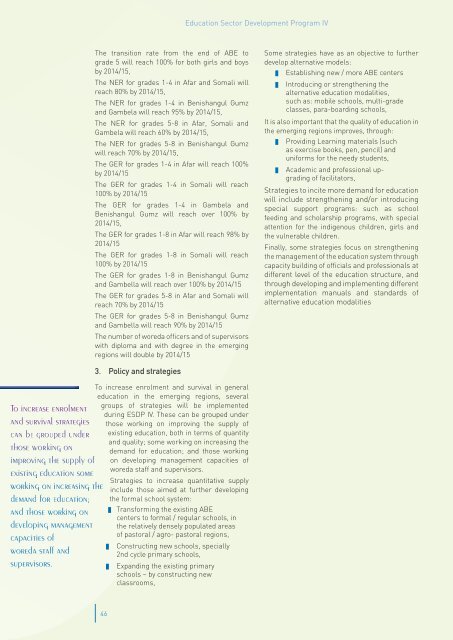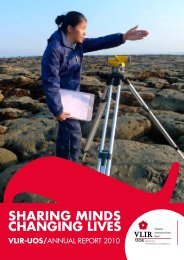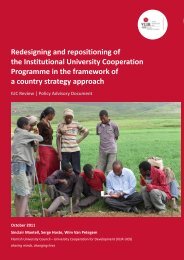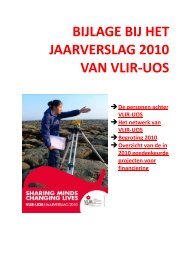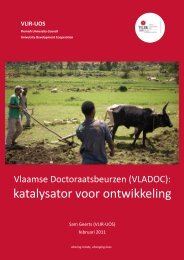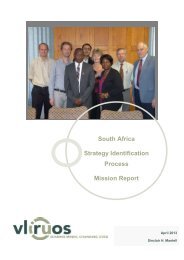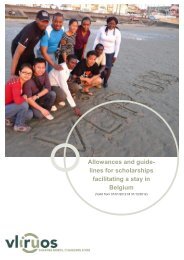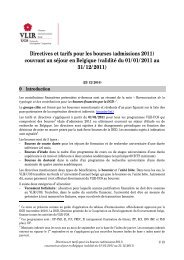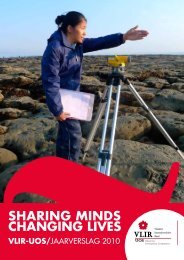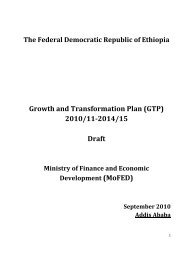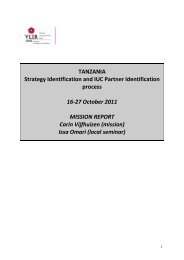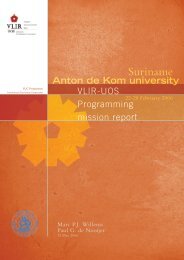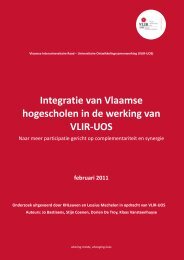Education Sector Development Program - VLIR-UOS
Education Sector Development Program - VLIR-UOS
Education Sector Development Program - VLIR-UOS
Create successful ePaper yourself
Turn your PDF publications into a flip-book with our unique Google optimized e-Paper software.
<strong>Education</strong> <strong>Sector</strong> <strong>Development</strong> <strong>Program</strong> IV<br />
The transition rate from the end of ABE to<br />
grade 5 will reach 100% for both girls and boys<br />
by 2014/15,<br />
The NER for grades 1-4 in Afar and Somali will<br />
reach 80% by 2014/15,<br />
The NER for grades 1-4 in Benishangul Gumz<br />
and Gambela will reach 95% by 2014/15,<br />
The NER for grades 5-8 in Afar, Somali and<br />
Gambela will reach 60% by 2014/15,<br />
The NER for grades 5-8 in Benishangul Gumz<br />
will reach 70% by 2014/15,<br />
The GER for grades 1-4 in Afar will reach 100%<br />
by 2014/15<br />
The GER for grades 1-4 in Somali will reach<br />
100% by 2014/15<br />
The GER for grades 1-4 in Gambela and<br />
Benishangul Gumz will reach over 100% by<br />
2014/15,<br />
The GER for grades 1-8 in Afar will reach 98% by<br />
2014/15<br />
The GER for grades 1-8 in Somali will reach<br />
100% by 2014/15<br />
The GER for grades 1-8 in Benishangul Gumz<br />
and Gambella will reach over 100% by 2014/15<br />
The GER for grades 5-8 in Afar and Somali will<br />
reach 70% by 2014/15<br />
The GER for grades 5-8 in Benishangul Gumz<br />
and Gambella will reach 90% by 2014/15<br />
The number of woreda officers and of supervisors<br />
with diploma and with degree in the emerging<br />
regions will double by 2014/15<br />
Some strategies have as an objective to further<br />
develop alternative models:<br />
❚ Establishing new / more ABE centers<br />
❚ Introducing or strengthening the<br />
alternative education modalities,<br />
such as: mobile schools, multi-grade<br />
classes, para-boarding schools,<br />
It is also important that the quality of education in<br />
the emerging regions improves, through:<br />
❚<br />
Providing Learning materials (such<br />
as exercise books, pen, pencil) and<br />
uniforms for the needy students,<br />
❚ Academic and professional upgrading<br />
of facilitators,<br />
Strategies to incite more demand for education<br />
will include strengthening and/or introducing<br />
special support programs: such as school<br />
feeding and scholarship programs, with special<br />
attention for the indigenous children, girls and<br />
the vulnerable children.<br />
Finally, some strategies focus on strengthening<br />
the management of the education system through<br />
capacity building of officials and professionals at<br />
different level of the education structure, and<br />
through developing and implementing different<br />
implementation manuals and standards of<br />
alternative education modalities<br />
To increase enrolment<br />
and survival strategies<br />
can be grouped under<br />
those working on<br />
improving the supply of<br />
existing education some<br />
working on increasing the<br />
demand for education;<br />
and those working on<br />
developing management<br />
capacities of<br />
woreda staff and<br />
supervisors.<br />
3. Policy and strategies<br />
To increase enrolment and survival in general<br />
education in the emerging regions, several<br />
groups of strategies will be implemented<br />
during ESDP IV. These can be grouped under<br />
those working on improving the supply of<br />
existing education, both in terms of quantity<br />
and quality; some working on increasing the<br />
demand for education; and those working<br />
on developing management capacities of<br />
woreda staff and supervisors.<br />
Strategies to increase quantitative supply<br />
include those aimed at further developing<br />
the formal school system:<br />
❚ Transforming the existing ABE<br />
centers to formal / regular schools, in<br />
the relatively densely populated areas<br />
of pastoral / agro- pastoral regions,<br />
❚<br />
❚<br />
Constructing new schools, specially<br />
2nd cycle primary schools,<br />
Expanding the existing primary<br />
schools – by constructing new<br />
classrooms,<br />
46


